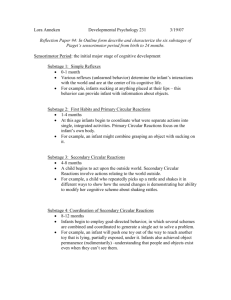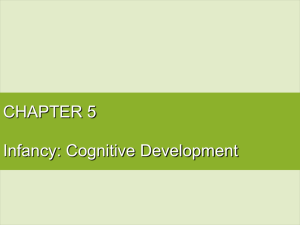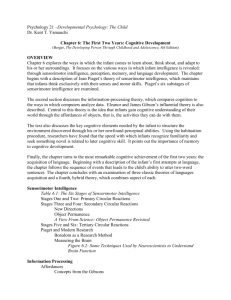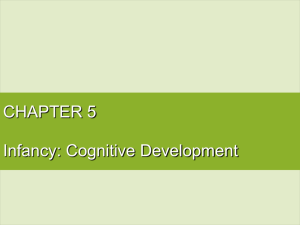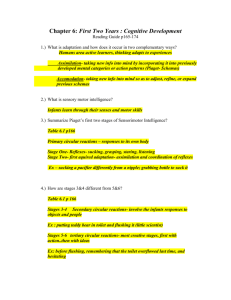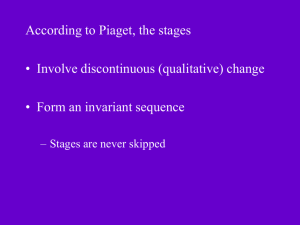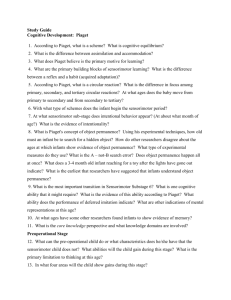Category hierarchies
advertisement
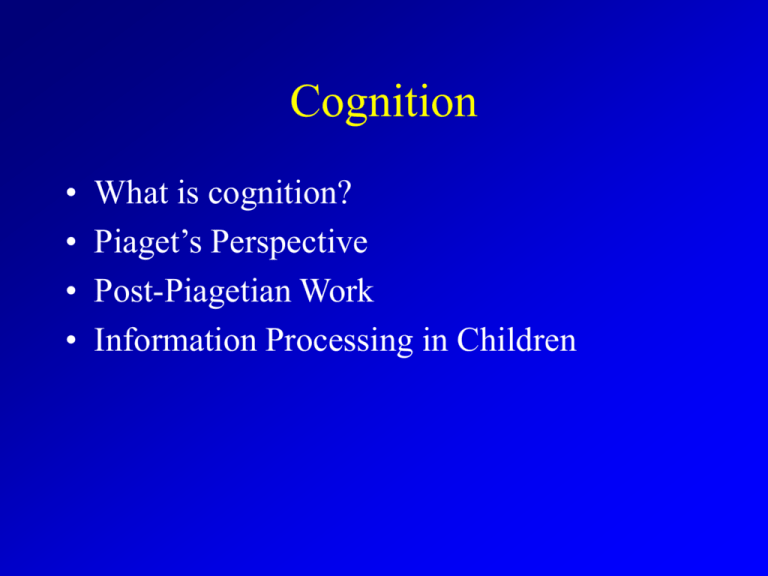
Cognition • • • • What is cognition? Piaget’s Perspective Post-Piagetian Work Information Processing in Children What is Cognition • Inner processes and products of the mind that lead to “knowing” • Includes all mental activity – Attending, remembering, symbolizing, categorizing, planning, reasoning, fantasizing etc…. • Research focuses on – What typical courses of development are – Indentifying individual differences – Mechanisms of cognitive development Cognitive Development - Piaget • Piaget Constructivism • The belief that children actively create knowledge rather than passively receiving it from the environment. – – – – Knowledge is constructed from experience Born with ability and desire to learn. Must be active to learn. Thinking/learning is internalization of physical knowledge. Adaptation • Fundamental process by which schemes are altered through experience. • Comprised of two complementary processes. Mechanisms of Change • Assimilation: information that fits into existing cognitive structure – schemas Mechanisms of Change • Accommodation: changing beliefs to fit new conceptual information Equilibration • Equilibration: regulatory process that maintains a functional balance between assimilation and accommodation Process of Equilibration • Children are satisfied with mode of thought (equilibrium) • Become aware of shortcomings in existing knowledge (disequilibrium) • Adopt a more sophisticated mode of thought (return to equilibrium) Characteristics of Stages of Cognitive Development • Each stage represents a qualitative change in thinking • Culturally Invariant • Includes structures and abilities of previous stages Stages of Cognitive Development • • • • Sensorimotor Preoperational Concrete Operational Formal Operational Sensorimotor Stage • Birth to 2 years of age • Use senses, motor skills to gain knowledge Circular Reaction • Way of building initial knowledge base by trying to repeat some chance event caused by their own motor activity. Sensorimotor Stage Substage 1: Simple Reflexes birth to 1 month Reflexes at the center of cognitive life Building blocks of sensorimotor Substage 2: First habits and Primary circular reactions 1-4 months Coordinate separate actions into single, integrated actions Substage 3: Secondary circular reactions 4-8 months Begin to act on outside world Substage 4: Coordination of secondary circular reactions 8-12 months Calculated approaches. Object permanence begins Substage 5: Tertiary circular reactions 12-18 months Carry out miniature experiments to observe consequences Substage 6: Beginnings of thought 18-24 months Capacity for mental representation or symbolic thought. Imagine where objects might be that they cannot see. Object Permanence Object Permanence Criticisms of Piaget’s Theory • Can have skills characteristic of two stages at one time period • Findings may only work with Piaget’s tasks Object Permanence • Piaget studied manual search--this may underestimate competence: – manual abilities may be poor – may not understand how to search (but understand objects) – motivational factors Post-Piagetian Perspectives Renée Baillargeon • Looking time as a measure of reactions to "possible" and "impossible" events • Violation-of-expectation: – possible event is consistent with the belief or expectation examined in the experiment – impossible event violates this belief or expectation • If the infant possesses the belief, they should find the impossible event novel or surprising and therefore look longer at the impossible than at the possible event. Habituation Events Test Events Possible Event Impossible Event Information Processing Types of Learning • Classical Conditioning – Blass et al. (1984) • Operant Conditioning – HAS paradigm – Foot-kick paradigm • Information Processing - Habituation Foot-kick Paradigm •Rovee-Collier and colleagues •Operant conditioning •Recognition memory Habituation Procedures • Used to assess cognitive competence – Declining interest indicates learning – Novelty responsiveness indicates discrimination of new versus familiar • Older infants habituate faster than younger infants • Infants of same age require more time to encode complex stimuli than simple stimuli Habituation Procedures • Orienting response: natural attentional response to new stimulus. • Habituation: decline in orienting response as initially novel stimulus becomes familiar. • Dishabituation: recovery of orienting response when an habituated stimulus changes. Habituation Habituation What is a Concept? •Definition: General ideas or understandings that can be used to group together objects, events, qualities, abstractions that are similar in some way •Infants form concepts from the beginning Core-knowledge theories: Infants have a biological predisposition to form concepts Piaget’s theory: Infants physical interactions with objects help them learn about concepts Information-processing approach: Through basic processing skills (e.g., association), infants make connections about many aspects of a concept Sociocultural theories: Looks at the way the social world influences an infant’s conceptual development Category Development •Infancy Broad category divisions help infants make accurate inferences Category hierarchies begin to develop Example: Inanimate object eating utensil spoon soupspoon, tablespoon Perceptual categorization: grouping by similar appearances, such as color, size, movement, begins early in infancy By age 1, function of objects is included in this process Around 18 months infants focus on specific parts of objects, not the whole object (e.g., must have wings to be a bird) Around 2 years of age infants focus on overall shape and what function goes with an object •Beyond Infancy Category Hierarchies Basic Level: First to develop due to consistent characteristics e.g., Doll Subordinate Level: Basic Level, plus extra characteristics e.g., Barbie doll Superordinate Level: Object does not have all of the consistent characteristics e.g., Toy Subordinate and superordinate categories are taught by caregivers Causal Understanding: Understanding “why” helps children learn categories Cause–effect relations Hearing that wugs are well prepared to fight and gillies to flee helped preschoolers categorize novel pictures like these as wugs or gillies (Krascum & Andrews, 1998). In general, understanding cause–effect relations helps people of all ages learn and remember. Number processing • Infants attend differentially as if they understand number concepts Number processing • Infants attend differentially as if they understand number concepts • Infants have a non-linguistic “counting” mechanisms Systems for number representation • Object-file representations – Infants visually track objects and their properties, including number – Quantity is limited (up to 4 objects)
